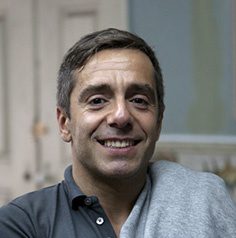Prof. Nuno Crespo

Nuno Crespo studied philosophy and aesthetics at Lisbon New University.
Currently he his the dean of the School of Arts of the Portuguese Catholic
University (UCP) where he teaches contemporary art theory and aesthetics.
His research interests are the relations between art, philosophy and criticism.
Besides the academic career he works as free lance art critic and art and curator.
He is associated researcher at CITAR where he coordinates a research group
about art, criticism and politics ( http://artecriticapolitica.weebly.com ). He has
been the organizer of seminars and workshops such has: Criticism and Value
Creation. International conference (Serrralves Museum, Lisbon New University,
Goethe Institut Lissabon); Mediterranean Congress on Aesthetics (Lisbon);
Time(s) of contemporaneity with Claire Bishop (CUNNY Graduate Center, NY).
As a curator he was in charge of exhibitions such as “Phantasms. Nuno Cera”
(Belém Cultural Center, Lisboa) “Corpo Impossível” with Adriana Molder, Noé
Sendas, Rui Chafes and Vasco Araujo (Queluz National Palace), “Encontro
Marcado” with Adriana Molder (Oviedo Fine Arts Museum), the anthological
exhibition of Pires Vieira (Lisbon City Museum), “Imponderável. Miguel Ângelo
Rocha” in Lisbon, “Involucão” of Rui Chafes (Casa-Museu Teixeira Lopes, Vila
Nova de Gaia), “Serralves” of João Luis Carrilho da Graça (AppletonSquare),
“Fragmentos. Arte Contemporânea na Colecção Berardo” (Museu de Arte
Contemporânea de Elvas), “Aires Mateus. Voids” (AppletonSquare), Riso (Museu
da Electricidade), “Dois Deles. Jorge Molder” at AppletonSquare (Lisbon),
“Anarchitecture. Spaces and Images in architecture and photography” (BES Art),
“Before and After” from the sculptor Miguel Angelo Rocha (Fundação Calouste
Gulbenkian, Lisboa), “Landscape as Architecture” about Paulo David e João
Gomes da Silva (Belém Cultural Center, Lisboa), Pedro Costa. Company
(Serralves Museum, Porto); Haus Wittgenstein. Art, architecture and philosophy
(MAAT Museum, Lisboa); A necessary realism. Photographys from José Pedro
Cortes (National Contemporary Art Museum, Chiado Museum, Lisboa); What can
art? (Museum-Studio Julio Pomar, Lisboa)
He was member of the curating team of the Prémio EDP – Novos Artistas (2006-
2011) and BESPhoto (2007-2009).
Regarding his publications he as been since 2003 senior art critic in the
portuguese newspaper Publico, and has some collaborations with the american
magazine ArtPapers. We can name his essays on Adriana Molder, Aires Mateus,
Axel Hütte, Bernd e Hilla Becher, Candida Höffer, Carrilho da Graça, Daniel
Blaufuks, Fassbinder, Gerhard Richter, Luisa Cunha, Miguel Ângelo Rocha, Nuno
Cera, Paulo David, Pedro Costa, Rui Chafes, Vasco Araújo, among others, and his
books “Wittgenstein e a Estética” (Assírio & Alvim), “Julião Sarmento. Olhar
Animal” (Cooperativa Árvore), “Arte. Crítica. Política.” (Tinta-da-China), Haus
Wittgenstein (MAAT Museum).
The fiction-science of Pedro Costa
This paper intends to identify, analyse and discuss the concepts of anti-cinema, cinema
without characters, politics without politics and the fiction-science in the filmography of the
Portuguese director Pedro Costa.
Pedro Costa works can be viewed as anti-cinema because it denies the traditional text, the
actors, the production, and the argument and lays in the hands of viewers a sequence of
images that are not a traditional narrative or materialize a worldview. All this aspects show
that his movies present a specific sensibility that one must understand. One can say that his
cinematography is about negation and that negation is the main force in his method. A good
example of this negation principle is present in the spaces where Costa makes his movies.
Spaces that aren’t sets, mas mainly spaces for thinking. The slum where he has placed his
more recent movies doesn't appear as a tool to illustrate a socio-political scene and story,
but, as Ranciére points out, he renounces scenario in order to be able to tell stories and, has
the director puts it, that slum is the ideal space for thinking (Pedro Costa in interview to
Neyrat). And all his cinematography makes present the transformation on a thought into
space: thinking becomes the walls that build the places of his movies.
Another negative aspect of this cinematography is the absence of characters. That is, what
moves Costa is the people and not the way in which people turn themselves in movie
characters. This is not an accidental transformation but its provoked by the director himself:
the actions, the dialogs, all scenes result of a preparatory work, a thought and a way to
assemble and link (montage) the images with each other. The cinematography we intend to
discuss has at it’s basis and as it’s origin a deep attention towards the world which
sometimes becomes an affliction that the director wants to deepen. To this attention we
have called, following the Austrian poet Rilke, Einsehen: a way of looking that doesn’t use
the beings he looks as window through which one observes the world but all his effort is to
look into the intimacy of those beings and to rest inside them.
The context in which this cinematography is developed, the choices it makes, the people he
chooses, provoke the birth of what we can name a politics without politics, that is, all this
movies articulate a deep political dimension without politicians nor intellectual and militant
discourses about poverty, integration or globalization. Finally, one must underline that
Costa cinematography is never documentary nor it appeals to the big phantasy and
pleasures of the movies: all his movies are in between all those things. We can name it a
science-fiction because it has to do with the effort to understand things around us with all
it’s colors, intensities and movements. Here fiction is not a mask (Benjamin), but a way to
sharpen reality and the movement to face reality is Pedro Costa ethics (Wittgenstein).